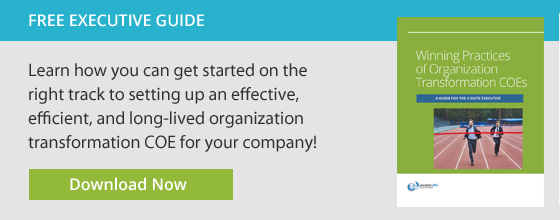An organization transformation COE’s success ultimately depends on its people—and staffing presents a number of challenges to building an effective COE. In a recent post, we touched on the challenges of hiring good people for a COE. However, even once you assemble the perfect organizational restructuring team, you still have to ensure that they are properly trained and prepared for the job ahead.
Capability building in an organization effectiveness COE happens on a number of levels, including:
- within the COE itself
- with related partners such as change managers or Six Sigma Black Belts
- with internal business clients
Let’s take a look at winning practices for capability building.
COE Talent and Resources: To Build or to Buy?
One of the first things to consider when building a COE should be whether you will be building internal resources and capabilities or contracting experts to do some or most of the work. Finding skilled talent, keeping them trained in organizational restructuring best practices, and preventing them from turning over can be difficult. You have to ensure the process you install to build capability not only trains up your resources but also maintains the proficiency levels needed.
For a number of our clients, including a major financial services firm, AlignOrg Solutions functions as their Organizational Effectiveness COE. This allows these companies to maintain a lean COE staff of one or two internal people. Instead of building their own internal resources and having to keep them trained and engaged, they call us when they need additional help. We have developed a solid relationship that this client’s internal customers aren’t even aware that we are external consultants—we simply introduce ourselves as part of the OE team.
Whether you build or buy your COE resources (or some type of hybrid approach), efforts to build and maintain capabilities are essential. The services the COE delivers for the organization need to be top notch. If business leaders question the capabilities of the COE, they may look to other sources for support when business-critical organization restructuring efforts are needed.
Your Sustainment Plan: Enabling Lasting Performance
When a football team (American football, that is) starts training in July or August, they begin with an intense regimen of two-a-day strength and conditioning training and on-the-field practices for several weeks. This intense training period allows the players to build the conditioning, the familiarity with the plays, and the execution skills to perform. Once the season starts, they continue practicing and training, albeit in maintenance mode. The key is staying in top condition over the duration of the season.
Training your COE team is very similar. It’s important to have a sustainment plan to build capabilities and make sure everyone understands how to use your tools and methodologies; and to ensure consistency in your practice.
Sustainment plans can include full-on training. They can also entail implementing periodic ways to build on and enhance previous trainings. For instance, one client of ours chooses a tool or training topic as the focus of a monthly webinar for their team members. There are many other approaches you can use as well, such as shadow consulting, coaching, reading, job rotations, project audits, etc. If you have partnered with an external partner on your tools and methodologies, consider also partnering with them to provide the capability building and sustainment plans needed to establish and maintain your team’s skills and know-how.
Building Capability in Support Groups and Partners
In addition to building capability in your core COE team, you will also need to consider how to build needed capability in your ancillary support groups and engagement partners, including HRBPs, Black Belts, and others.
Most importantly, you should train internal partners in how to work with your COE:
- They need to be aware of what your COE does to overlap.
- They should ask good questions that will foster a partnering mindset.
- They also need to be able to speak about your capabilities intelligently with business leaders to ensure your COE is engaged at the right times
Developing Awareness in Business Leaders
For your organization to leverage your COE effectively, business leaders need to be familiar with the methodologies and organization transformation principles you are using. This will ensure that they know:
- · when it’s appropriate to call you (and when not to call)
- · what your capabilities are (and what they aren’t), and
- · how to be good clients
Why is this important? Let’s look at an example. A client calls and says they want your help in .organizational restructuring. They have a staff meeting next week and invite you to come to the meeting and help them to redesign the organization’s structure during a two-hour segment of the meeting. You know there’s no significant way to help them in two hours. In reality, it might take three or four solid days of working together to get the kind of outcome they want and need. Because they lack basic understanding of your approach and the issues at hand, you must now spend time helping this client understand that their request is substantial and requires a much more robust approach than the two-hour spot they offered on their agenda.
Engaging in building awareness with business leaders ahead of time can help ensure that when clients do call you, they have realistic expectations so you can get to work helping them instead of having to spend time educating them and/or potentially disappointing them.
4 Key Questions to Keep Your Capability Building on Track
The following questions can help you stay on track towards developing effective training and capability building methods for your COE:
- Will you build or buy your COE talent/resources?
- What is your sustainment plan?
- How will you build capability in support groups and partners?
- What awareness development will business leaders need?
Addressing these issues will go a long way towards ensuring that your COE is well prepared to efficiently and effectively assist with change transformation in your organization.

